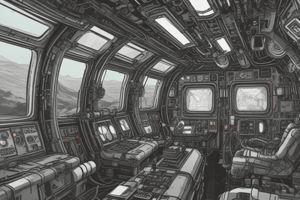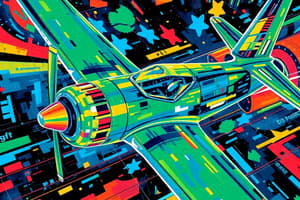Podcast
Questions and Answers
What are the primary control systems in an aircraft?
What are the primary control systems in an aircraft?
- Wing flaps and trim systems
- Ailerons, elevator, and rudder (correct)
- Vertical stabilizers and horizontal stabilizers
- Spoilers and leading edge devices
Which of the following are secondary control systems in an aircraft?
Which of the following are secondary control systems in an aircraft?
- Trim systems (correct)
- Ailerons
- Spoilers (correct)
- Rudder
What is the function of ailerons?
What is the function of ailerons?
Control roll about the longitudinal axis.
Define adverse yaw.
Define adverse yaw.
What are differential ailerons?
What are differential ailerons?
What is meant by coupled ailerons and rudder?
What is meant by coupled ailerons and rudder?
What is a flaperon?
What is a flaperon?
Describe the elevator's function.
Describe the elevator's function.
What is a T-tail design?
What is a T-tail design?
Define a stabilator.
Define a stabilator.
What is a canard?
What is a canard?
What does the rudder control?
What does the rudder control?
Describe the function of plain flaps.
Describe the function of plain flaps.
What is a split flap?
What is a split flap?
What do slotted flaps do?
What do slotted flaps do?
What is the purpose of trim tabs?
What is the purpose of trim tabs?
What are balance tabs?
What are balance tabs?
How do servo tabs function?
How do servo tabs function?
What are antiservo tabs used for?
What are antiservo tabs used for?
Flashcards are hidden until you start studying
Study Notes
Flight Control Systems
- Primary Control Systems: Include ailerons, elevators (or stabilators), and rudders.
- Secondary Control Systems: Consist of wing flaps, leading edge devices, spoilers, and trim systems.
Ailerons
- Function: Control aircraft roll about the longitudinal axis.
- Operation: Moving the control stick/yoke right deflects the right aileron upwards and the left aileron downwards.
- Effects: Upward aileron deflection decreases lift on that wing while downward deflection increases lift on the opposite wing, causing the aircraft to roll right.
Adverse Yaw
- Definition: The tendency of an airplane to yaw away from the intended direction due to differential lift and drag from aileron deflections.
- Characteristics: More pronounced at lower airspeeds.
Differential Ailerons
- Design: Up aileron moves a greater distance than the down aileron, creating additional drag.
- Purpose: Balances drag forces to minimize adverse yaw.
Frise-Type Ailerons
- Design: Aileron pivots on an offset hinge when raised, increasing drag.
- Effect: Equalizes drag from the opposing lowered aileron, reducing adverse yaw and maintaining airflow over the lowered aileron.
Coupled Ailerons and Rudder
- Mechanism: Rods and springs connect rudders and ailerons to counteract adverse yaw.
- Flexibility: Can be overridden for intentional aircraft slipping.
Flaperons
- Integration: Combine functions of ailerons and flaps, enhancing both roll control and lift.
Elevator
- Function: Controls aircraft pitch by regulating airflow over the tail.
- Action: Up-elevator position decreases camber and pushes the tail down.
Tail Designs
- T Tail: Features a horizontal stabilizer mounted atop the vertical stabilizer.
- V-Tail: Comprises two slanted tail surfaces that act as horizontal and vertical stabilizers.
Stabilator
- Definition: A horizontal tail surface that pivots around a central hinge, functioning as both stabilizer and elevator.
Canard
- Description: A horizontal stabilizer positioned in front of the main wings, enhancing control.
Rudder
- Function: Regulates yaw direction.
- Operation: Pushing a pedal moves the rudder, affecting airflow and changing yaw direction. Most effective at higher speeds.
Flap Types
- Plain Flap: Increases airfoil camber for greater lift and drag, moving the center of pressure aft.
- Split Flap: Extends from the lower surface, yielding a greater lift increase than plain flaps but generating significant drag.
- Slotted Flap: Features a ducted design that enhances lift by preventing airflow separation at high angles of attack.
- Fowler Flap: Slides backwards to increase both camber and wing area, significantly enhancing lift while minimizing drag initially.
Leading Edge Devices
- Components: Include fixed slots, movable slats, leading edge flaps, and cuffs.
- Functionality: Enhance lift by directing airflow and delaying separation at high angles of attack.
Spoilers
- Purpose: Increase drag and reduce lift to control aircraft descent and roll, often used on gliders and some aircraft for roll control.
Trim and Control Tabs
- Trim Tabs: Adjust airflow to maintain control surface positions, reducing control effort.
- Balance Tabs: Decrease control forces by moving in the opposite direction of the primary surface when deflected.
- Servo Tabs: Assist control surfaces to move in the direction of pilot input, reducing workload.
- Antiservo Tabs: Move similarly to control surfaces to decrease sensitivity and provide trim.
Studying That Suits You
Use AI to generate personalized quizzes and flashcards to suit your learning preferences.



